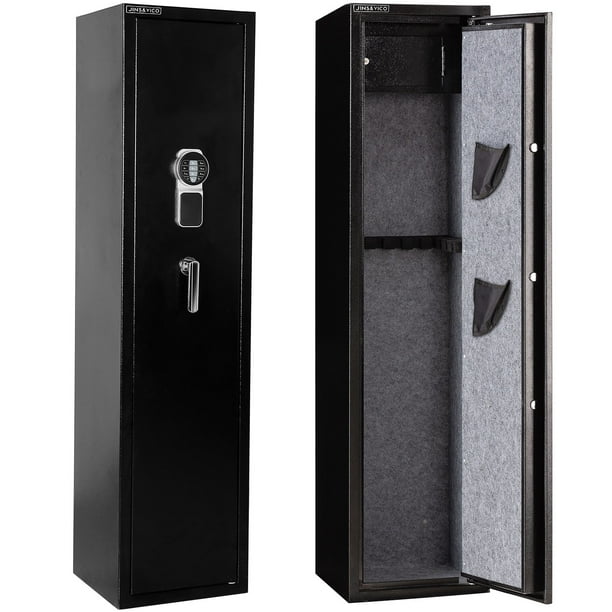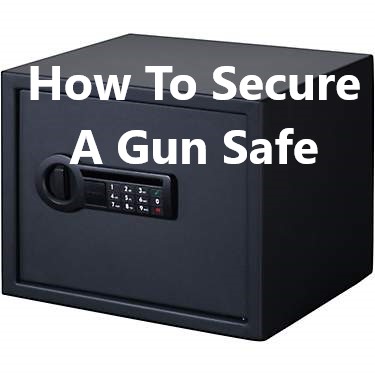Owning a gun safe is one of the best first steps you can take to help keep your firearms safe, but it’s only the first step. Securing your gun safe so that the safe itself can’t be stolen or tampered with is just as important as owning a safe in the first place.
Here’s what you need to know about keeping a gun safe secure, securing one in the first place, and the different options you have for different kinds of gun safes.
Why Gun Safes Are Important
Gun safes are one of the most important pieces of firearm safety equipment you can have in your home. Not only do gun safes help keep your firearms safe from would-be thieves, tampering, and damage, but they can also keep other people in your home safer.
A good gun safe does double duty as a protective measure as well as a smart storage solution for your firearms and gun accessories.
If you don’t already have a gun safe in your home, consider getting one as soon as you can. And if your gun safe is getting a little crowded, don’t hesitate to add another just to help make sure everything is as secure as it can be. If you want to learn more about gun safes have a look at our article gun safes under $500.
Common Threats To Your Gun Safe
One of the first steps to keeping your gun safe secure is knowing the main threats that can cause damage to your safe, or make it less effective. There are three key threats to understand when you’re getting and securing your safe. 
Weight
Weight can be a good theft deterrent, but it can also cause other problems when it comes to gun safes. Since gun safes are a considerable weight in your home, they can get too heavy for your walls or flooring.
Avoid excess weight by making sure you always place your safe in a well-braced place, preferably on the ground floor or in the basement where weight is less of a structural concern. You should also consider spacing out your gun safes if you have more than one to avoid excess weight stress on any one part of your home.
Natural Disasters
The most common natural disasters that damage gun safes, and their contents, are floods and fires. While there aren’t many safes out there that are truly flood- or fire- proof, there are a few.
If you need to place your gun safe anywhere it might be affected by fire or flooding, consider getting better water and fire proofing. Ideally, though, you should place your gun safe somewhere those risks are less likely to minimize the chances of loss or damage.
Theft
Safes of all kinds can be a common target for theft if your home is ever broken into. Experienced thieves often even bring equipment to help get heavy safes out quickly and without drawing too much attention to themselves.
Securing your safe to the wall or floor of your home is one of the best ways you can avoid the risk of theft. Since most thieves want to be in and out of your home quickly, they usually won’t stick around to attempt picking locks or defeating a lock mechanism on your safe.
How To Secure A Gun Safe In Your Home
There are a few different options if you want to keep your safe secure in your home. The best protection will be a combination of these techniques, but even using just one is better than not using any at all.
Think about different ways you can secure your gun safes at home before committing to one. Spending some time brainstorming can help make your safe more secure than if you rush to get it installed and secure.
Attach The Safe To Your Home
The first, and possibly best, way to secure your gun safe is to physically secure it to the wall or floor. Most gun safes will have attachment points for bolts and other mounting equipment to make it easier to install the safe directly to your home.
Bolting your safe into cement is usually the safest option. Wood, drywall, and other building materials aren’t as secure and can be broken much more easily.
If you do need to secure your safe to something other than concrete, consider using an adhesive to make the connection permanent. Gluing your safe to the wall or floor will mean you can’t take it with you if you ever decide to move, but it will also keep the safe much more secure and much less likely to be stolen.
Secure With A Cable Or Other Attachment
If securing your safe directly to the wall or floor isn’t an option, or you don’t want to create a permanent attachment in case you need to move later, there are other options. Using a security cable to link your safe to heavy furniture is probably the next best option, though it’s not as secure as installing the safe directly into your home.
Most gun safes will come with a security cable, and that’s probably the best option. Security cables are usually made from woven steel or titanium wire that’s designed to be incredibly difficult to cut or break.
That’s important because regular cables can be cut or broken much more easily.
Security cable should be looped through at least two attachment points on your safe, and then connected to the heaviest available furniture, or around a pillar or other architectural element. The connection helps prevent theft and is more difficult to thwart than just laying the safe on the floor. If you want a quality fire rated safe, check our guide on which is the best fireproof gun safe under $500.
Good Locks
Having a good locking mechanism is also important for securing your safe. Make sure you’re familiar with the locking mechanism, keep any emergency keys separate from your safe, and don’t make emergency opening options obvious to help protect your safe.
Concealment
The last option to keep your safe secure is also one of the most important. Concealing your safe makes it much less likely that someone will try and break in and take it in the first place, and will make anyone looking for your safe waste time trying to find it.
One of the most common ways to conceal a gun safe is to get and under bed safe with a bed skirt. No one who doesn’t know the safe is there will be likely to spot it, and under your bed isn’t the first place many people will look for a hidden safe.
You can also get shelves that are designed to hold a small safe or disguise a larger safe inside of a cabinet façade. These options not only help to conceal your safe and keep it more secure, they also help improve the appearance of your gun safe and help it blend into your décor.
Even something as simple as keeping a piece of fabric or a sheet over your safe can help to keep it concealed, though this method isn’t as effective.
Another good way to conceal your safe is to keep it in a less-used room in your home, away from other valuables or anything that might attract the attention of a thief. That way people are much less likely to notice you have a gun safe, whether you conceal the safe in other ways or not.
Keeping your gun safe secure doesn’t have to be difficult, but there can be big consequences if you don’t secure it properly. Make sure you have a security plan before installing your safe if you want to keep your firearms and housemates safer in your home.

Jerry Miculek is an experienced firearms and optics expert. Guns are not just a hobby for him, they are his passion and life. You can learn more about Jerry on our About us page.

